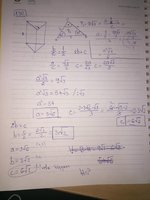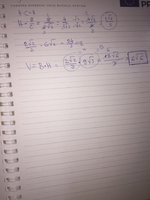Ana.stasia
Junior Member
- Joined
- Sep 28, 2020
- Messages
- 118
The base of the prism is a right-angled triangle with the surface area of 9 times square root of 3 and one angle of 30 degrees. The surface area of the biggest rectangle is 8cm2. Calculate the volume of the prism.
I tried to calculate the edges of the triangle first. Using sin and the surface area which is 9 times square root of 3.

I calculated that c was the biggest and therefore I came to a conclusion that the side with c was the biggest and therefore one whose surface area equals 8cm2.
So I calculated H.

The volume i got was 6 times square root of 6. The solution from the book is 12 times square root of 3. Where did I go wrong?
I tried to calculate the edges of the triangle first. Using sin and the surface area which is 9 times square root of 3.

I calculated that c was the biggest and therefore I came to a conclusion that the side with c was the biggest and therefore one whose surface area equals 8cm2.
So I calculated H.

The volume i got was 6 times square root of 6. The solution from the book is 12 times square root of 3. Where did I go wrong?
